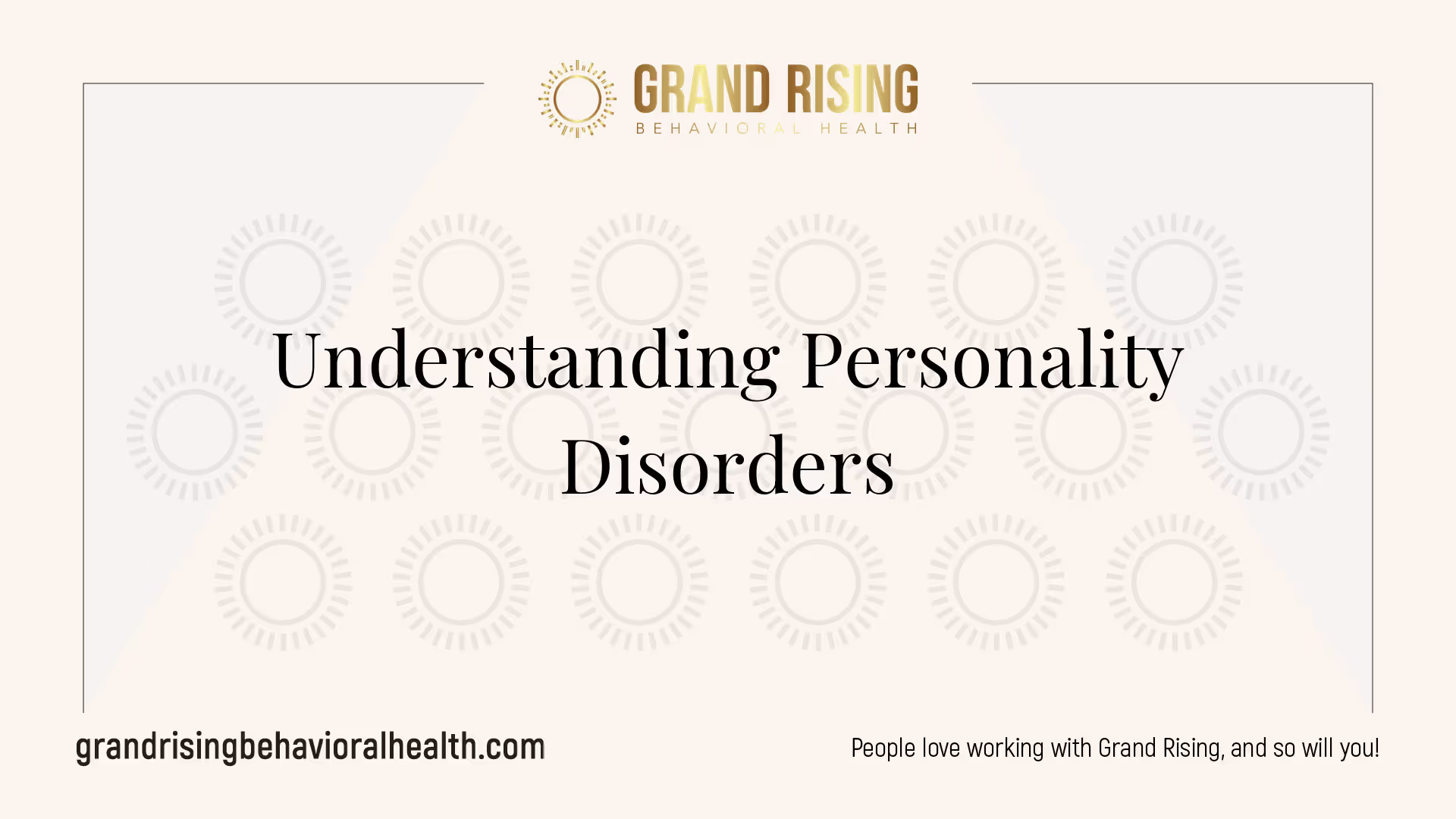Understanding the Cluster System of Personality Disorders
Explore the cluster system of personality disorders explained, from traits to treatment and their impact on life.


Understanding Personality Disorders
Introduction to Personality Disorders
Personality disorders are mental health conditions characterized by persistent patterns of behavior, thinking, and functioning that deviate from cultural expectations. These disorders affect how individuals perceive themselves and interact with others. According to Johns Hopkins Medicine, personality disorders are divided into three subtypes known as clusters:
There are a total of ten specific personality disorders classified under these three clusters, each presenting unique traits and challenges.
Importance of Classifying Personality Disorders
Classifying personality disorders into distinct clusters is essential for effective diagnosis and treatment. The DSM-IV (1994) organizations the ten personality disorders into three main categories:
ClusterPersonality DisordersAParanoid, Schizoid, SchizotypalBAntisocial, Borderline, Histrionic, NarcissisticCAvoidant, Dependent, Obsessive-Compulsive
This classification assists mental health professionals in identifying symptoms and devising appropriate treatment plans. The recent DSM-5-TR introduced a hybrid model that combines traditional classifications with a dimensional approach, focusing on impairments in personality functioning and pathological traits [1].
Understanding these classifications is crucial for those living with these conditions and for their families and friends. By recognizing the specific characteristics of each disorder, individuals can seek tailored support and interventions to manage their symptoms effectively.

Cluster A Personality Disorders
Cluster A personality disorders are often described as odd or eccentric, characterized by social awkwardness and a tendency toward unusual behavior. This cluster includes three specific disorders: paranoid, schizoid, and schizotypal personality disorders. Each disorder comes with its unique traits and challenges in interpersonal relationships.
Characteristics of Cluster A Disorders
Individuals with Cluster A personality disorders typically exhibit the following characteristics:
CharacteristicDescriptionSocial WithdrawalMany individuals feel uncomfortable in social situations and may avoid them altogether.Eccentric BehaviorIndividuals might display quirky or unconventional behavior.Distorted ThinkingSome may have unusual beliefs or abnormal thought patterns.Difficulty Relating to OthersBuilding and maintaining relationships can be particularly challenging.
These traits can significantly impact their daily lives, making it harder to interact socially or work cooperatively with others. Mental health professionals are the only ones equipped to diagnose these disorders, emphasizing the importance of seeking expert help.
Specific Cluster A Disorders
Understanding the specific disorders within Cluster A can help to clarify the symptoms and implications of each.
DisorderKey CharacteristicsParanoid Personality DisorderIndividuals often harbor distrust and suspicion towards others, feeling that they are being deceived or exploited. They may interpret benign actions as threatening and often remain guarded in relationships. For more details, refer to the article on paranoid personality disorder: living with constant suspicion.Schizoid Personality DisorderThose diagnosed tend to be detached from social relationships and express a limited range of emotions in interpersonal settings. They prefer solitary activities and often appear indifferent to social norms. Further information can be found in schizoid personality disorder: when solitude is preferred.Schizotypal Personality DisorderThis disorder involves acute discomfort in close relationships, cognitive or perceptual distortions, and eccentric behaviors. Individuals may experience odd beliefs or magical thinking, impacting their social interactions. More insights are available in other resources.
Cluster A personality disorders can often lead to significant distress in social and personal settings. Effective diagnosis and treatment are essential for individuals navigating the nuances of these disorders.
Cluster B Personality Disorders
Traits of Cluster B Personality Disorders
Cluster B personality disorders are often characterized by dramatic, erratic, or intensely emotional responses. Individuals with these disorders frequently display unpredictable behaviors and a strong need for attention and validation. The main traits associated with Cluster B disorders include:
These traits can cause significant distress not only for the individual but also for those around them.
Examples of Cluster B Disorders
There are four primary disorders classified within Cluster B:
DisorderDescriptionAntisocial Personality Disorder (ASPD)Characterized by a disregard for societal norms and the rights of others; individuals may break laws and manipulate others for personal gain. Learn more about ASPD.Borderline Personality Disorder (BPD)Marked by emotional instability, relationship difficulties, and issues with self-image; individuals may experience rapid mood swings and have intense reactions to perceived abandonment. Learn more about BPD.Narcissistic Personality Disorder (NPD)Involves an inflated sense of self-importance, a deep need for admiration, and a lack of empathy for others; individuals may exploit relationships and perceive themselves as superior. Learn more about NPD.Histrionic Personality Disorder (HPD)Characterized by an excessive need for attention and emotionality, individuals may behave in overly dramatic ways and be preoccupied with their appearance. Learn more about HPD.
Understanding these disorders is essential for recognizing the challenges faced by individuals within Cluster B. Treatment approaches vary and may include therapies like Dialectical Behavior Therapy (DBT) and Mentalization-Based Treatment for managing symptoms effectively. The information provided gives a foundational overview of some of the most significant aspects of these personality disorders, acting as a guide for those seeking to comprehend the cluster system of personality disorders explained.
Cluster C Personality Disorders
Cluster C personality disorders are characterized by anxious thinking or behavior. This cluster includes three main types of disorders: Avoidant Personality Disorder, Dependent Personality Disorder, and Obsessive-Compulsive Personality Disorder (OCPD) Johns Hopkins Medicine.
Features of Cluster C Personality Disorders
Individuals with Cluster C disorders often exhibit symptoms that align closely with anxiety and depressive disorders. These disorders are marked by chronic fearfulness and anxiety, which can lead to behaviors that aim to avoid perceived threats or criticism. Common features include:
The following table summarizes the key features of each disorder found within Cluster C:
DisorderKey FeaturesAvoidant Personality DisorderFear of criticism, avoidance of social interactions, feelings of inadequacyDependent Personality DisorderDependence on others, fear of being alone, difficulty making decisions without excessive adviceObsessive-Compulsive Personality Disorder (OCPD)Preoccupation with perfectionism, excessive control, and rigid adherence to routines
Type of Disorders in Cluster C
Cluster C encompasses three specific personality disorders:
These disorders demonstrate distinct behaviors and thought patterns, reflecting the broader category of anxious or fearful traits seen in Cluster C personality disorders. Understanding these features helps in recognizing and addressing the specific challenges faced by individuals with these disorders.
Diagnosis and Treatment
Identifying Personality Disorders
The identification of personality disorders is a nuanced process. An individual must demonstrate significant and enduring difficulties in at least two of the following areas: distorted perceptions and thinking patterns, problematic emotional responses, over- or under-regulated impulse control, and interpersonal difficulties [2]. Diagnosis is rare in children due to the need for these traits to represent long-standing issues across time.
Professionals utilize various tools and assessments to evaluate symptoms thoroughly. In many cases, these evaluations are conducted in a clinical setting to establish a clear understanding of an individual’s behavior, thoughts, and emotional responses.
Assessment FocusDescriptionDistorted PerceptionIdentifying skewed thinking patternsEmotional ResponsesEvaluating intensity and appropriatenessImpulse ControlUnderstanding impulse managementInterpersonal SkillsObserving relationships and communication
For more in-depth information, see our article on understanding personality disorders: an overview.
Approaches to Treating Personality Disorders
Treatment for personality disorders varies widely based on the specific disorder and the individual’s needs. Common approaches include therapy, medication, and support groups. In many cases, therapy is the primary method for managing symptoms and improving everyday functioning.
Common therapeutic approaches include:
Medications may also be prescribed to help alleviate specific symptoms, such as anxiety or depression, often co-occurring with personality disorders.
Treatment TypeEffectivenessCognitive Behavioral TherapyEffective for various disordersDialectical Behavior TherapyHighly effective for borderline personality disorderMedicationHelps with co-occurring symptoms
Furthermore, joining support groups can offer a sense of community and understanding, benefiting those managing personality disorders. For specific disorders like borderline and narcissistic personality disorders, resources are available for deeper insights, such as borderline personality disorder: navigating emotional instability and narcissistic personality disorder: beyond vanity.
Personality disorders represent a complex area of mental health requiring tailored approaches based on individual circumstances and symptoms.
Impact of Personality Disorders
Understanding the impact of personality disorders is crucial for recognizing how these conditions influence daily life, relationships, and overall functionality. The ramifications can be significant, affecting both personal and social aspects of life.
Social and Personal Ramifications
Personality disorders can present various social and personal challenges. Individuals with these disorders may experience difficulties in forming and maintaining relationships, as their behavior may be perceived as odd or erratic. For example, those with Cluster A disorders, such as paranoid personality disorder, often deal with social awkwardness and withdrawal, leading to isolation [6].
Cluster B disorders, such as narcissistic personality disorder, can impact social interactions due to dramatic behaviors and a tendency to seek attention and validation from others. This can lead to conflicts and misunderstandings in interpersonal relationships [7].
People with Cluster C disorders, such as avoidant personality disorder, demonstrate chronic fearfulness which influences their ability to engage socially or pursue opportunities. They may often avoid situations that could lead to criticism or rejection [6].
Cluster TypeCommon FeaturesExample DisordersCluster AOdd or eccentric behavior, social awkwardnessParanoid Personality Disorder, Schizoid Personality DisorderCluster BDramatic or erratic behavior, emotional instabilityAntisocial Personality Disorder, Histrionic Personality DisorderCluster CAnxious or inhibited behavior, fear of criticismAvoidant Personality Disorder, Dependent Personality Disorder
Managing Life with a Personality Disorder
Living with a personality disorder can necessitate various management strategies to improve daily functioning and overall wellbeing. Treatment plans often include therapy, medication, and lifestyle changes tailored to the individual's specific needs.
Therapeutic Approaches: Different therapeutic modalities can be beneficial. For example, Dialectical Behavior Therapy (DBT) has proven effective for individuals with borderline personality disorder [8]. Other methods include mentalization-based treatment and schema therapy, which aim to help individuals recognize and alter dysfunctional thought patterns [9].
Support Systems: Building a strong support system is essential for managing life with a personality disorder. This includes connecting with friends, family, support groups, or mental health professionals, fostering a sense of belonging and understanding.
Self-Care Practices: Encouraging self-care practices such as mindfulness, maintaining a balanced diet, engaging in physical activity, and pursuing hobbies can improve mental health. Regular routines and setting achievable goals help in building stability and resilience against emotional fluctuations.
By recognizing the complexities of personality disorders and exploring effective management strategies, individuals can navigate their challenges more successfully, enhancing their quality of life. For further insights on personality disorders, consider reading about understanding personality disorders: an overview.
References
[2]:
[3]:
[4]:
[5]:
[6]:
[7]:
[8]:
[9]:
More Resources
A team ready to start your journey.
Get in touch — today.
We are a safe space – a haven for exceptional individuals to receive discreet, personalized, in-person treatment and care.
.png)









